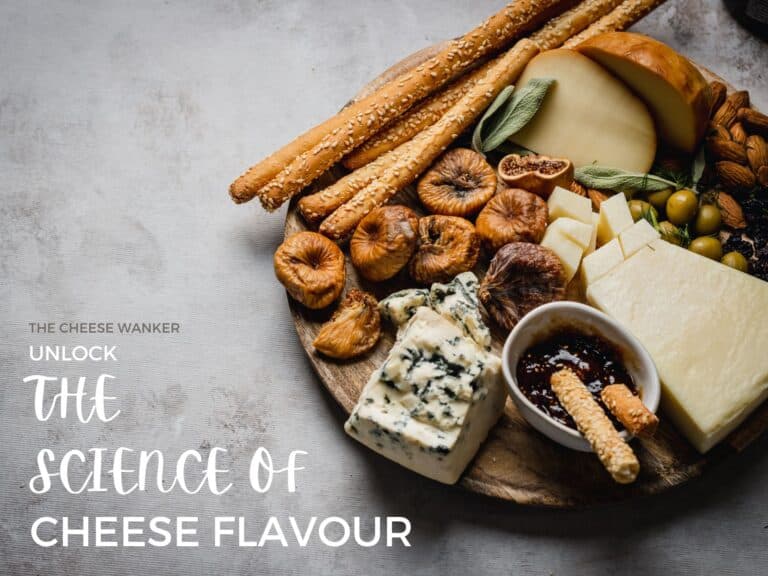Cheese enthusiasts and connoisseurs often revel in its diverse and complex flavours. Yet, there is a pervasive but misleading term used to describe the flavour of cheese – “sharp”. In this blog post, we will explore why using “sharp” to describe cheese flavour is problematic and suggest more accurate alternatives for describing aroma and flavour.

READ MORE: The world’s most complete glossary of cheese terminology →
The Problem with “Sharp”
The term “sharp” is a rather ambiguous and imprecise way to describe the organoleptic properties of cheese. When someone says a cheese is “sharp”, it can mean different things to different people.
Moreover, this ambiguity can lead to many misunderstandings, hindering meaningful discussions about the distinct characteristics of cheeses.
Cheese flavour is influenced by various factors, including ageing, production methods, milk source and the presence of specific microorganisms. When we use a blanket term like “sharp” to describe the taste of cheese, we overlook the intricate nuances that make each cheese unique.
A more accurate lexicon for cheese description
To encourage a more precise and meaningful dialogue about cheese flavours, let’s delve into some alternative terms that can be used to describe its aroma and flavour.
1. Savoury
Let’s start our organoleptic exploration with the most ubiquitous of cheese flavours. Savoury flavour in cheese, often referred to as ‘umami’, is a palate-pleasing sensation that elevates the overall taste experience.
This highly sought-after quality develops in cheese through the addition of salt and natural ageing process. When you eat a cheese with a pronounced savoury note, you’re likely detecting the presence of glutamate compounds, which evoke a profound sense of depth and richness on the taste buds.
Umami-rich cheeses, such as Parmigiano Reggiano, leave an indelible impression, enticing the senses with a symphony of complex and profoundly satisfying flavours.
2. Tangy
Next, we have a flavour often associated with goat cheeses. Tangy flavour in cheese imparts a lively and invigorating sensation that adds a delightful dimension to its taste profile.
This characteristic tanginess arises from the presence of lactic acid, which develops as cheese undergoes fermentation and ageing. When tasting a tangy cheese, your palate detects a pleasing, slightly acidic bite that can range from subtle to bold.
Undoubtedly, tangy cheeses like fresh Chèvre and aged goat cheeses bring a refreshing and zesty quality. Hence, they are firm favourites for those who appreciate cheeses with a vibrant and lively character.
3. Spicy
Now onto my personal favourite!
Spicy flavour in cheese is a fiery element that adds a dynamic kick to its overall taste. Of course, this spiciness can be achieved by incorporating ingredients like chili and pepper into the cheesemaking process. However, a number of traditional cheeses display spicy notes without any extra ingredients.
A great example of this is Provolone Piccante. This aged Italian pasta filata cheese is made using a small amount of goat rennet. And this imparts a touch of spice to the final cheese. Furthermore, a blue cheeses like Stilton and Roquefort also display a spicy flavour imparted by the blue mould.
4. Nutty
The nutty flavour in cheese introduces a warm and comforting dimension that evokes the essence of various nuts, such as hazelnuts, almonds or cashews.
This delightful quality arises from the interaction of enzymes during cheese ageing. And the end result isa distinct nuttiness that ranges from subtle to pronounced. When you eat a nutty cheese, your taste buds are treated to a rich, slightly sweet and roasted nut-like essence.
Cheeses like Gruyère and Comté often exhibit this nutty characteristic. Hence, they are a beloved choice for those who appreciate the comforting notes reminiscent of their favourite nuts.
5. Earthy
Another term that describes cheese flavour better than sharp is earthy. Earthy flavour in cheese introduces a grounding and natural quality that often conjures images of the forest floor or the richness of soil.
This distinctive characteristic typically emerges as cheese interacts with the environment during the ageing process. When you taste an earthy cheese, your palate is greeted by deep, mineral-like undertones that create a unique and complex flavour profile.
Cheeses like Brie de Meaux and Camembert often exhibit this earthy quality, offering a savoury, sometimes slightly mushroom-like experience that connects cheese lovers to the world’s natural and rustic elements.
6. Grassy
Grassiness in cheese brings a refreshing and verdant quality reminiscent of the outdoors and meadows. This unique attribute often emerges in cheeses made from milk sourced from cows that graze on lush pastures.
When you taste a grassy cheese, you’ll detect hints of fresh green foliage, and a crisp, slightly vegetal note.
Cheeses like young Chèvre and artisanal Camembert often showcase this delightful characteristic. As a result, they are a perfect choice for those seeking bright, garden-like undertones that evoke the natural beauty of the countryside.
7. Herbaceous
Herbaceous flavours in cheese infuse your palate with the essence of aromatic herbs, delivering a burst of fresh, botanical notes. When you eat an herbaceous cheese, you’ll encounter flavours reminiscent of basil, rosemary, thyme or other culinary herbs, adding a delightful aromatic quality.
Cheeses like Sainte-Maure-de-Touraine and Rocamadour feature this herbaceous quality, inviting your senses on a culinary journey through fragrant gardens and kitchens filled with culinary delights.
8. Fresh hay
Fresh hay flavour in cheese evokes the pastoral charm of sun-drenched fields and haylofts. This distinctive characteristic is often derived from the diet of the animals that provide the milk for cheese, particularly when they graze on natural pastures.
When you savour a cheese with fresh hay notes, you’ll experience a mild, subtly sweet aroma reminiscent of newly cut grass and sun-kissed hay.
Cheeses like Beaufort and Abondance beautifully capture this rustic quality, transporting your senses to the heart of countryside landscapes and the simple pleasures of rural life.
9. Wildflower
Next, we have a burst of summer with wildflowers.
Wildflower flavour in cheese imparts a delicate and alluring quality reminiscent of nature’s untamed beauty. This unique attribute is often influenced by the diverse wildflowers that flourish in the animals’ grazing pastures. Thanks to this diet, their milk is infused with a complex bouquet of floral notes.
When you taste a cheese with wildflower nuances, you’ll discover a symphony of gentle, floral fragrances and flavours. Let yourself be transported to meadows in full bloom and the sweet nectar of diverse blossoms.
Young goat cheeses beautifully showcase this wildflower characteristic, offering a sensory journey into the unspoiled landscapes where these cheeses are crafted.
10. Fruity
This is another characteristic that is reminiscent of summer.
Fruitiness in cheese imparts a delightful and sweet-savoury fusion, reminiscent of various fruits such as pineapple, apricot or pear. This captivating characteristic often arises from the interactions between enzymes, cultures and ageing processes, creating a complex interplay of fruity notes.
When you taste a cheese with fruity undertones, your taste buds are treated to a harmonious blend of both subtle and pronounced fruitiness. This sensory experience may conjure images of tropical orchards or orchard blooms.
Cheeses like Gorgonzola Dolce and Manchego can display these delightful fruity qualities, adding a nuanced and enticing dimension to your cheese journey.
11. Caramelised
Caramelised notes in cheese introduce a luxurious and sweet sophistication reminiscent of the rich and indulgent qualities of caramel. This distinctive attribute often emerges during the cheese ageing process as natural sugars break down and develop complex, caramel-like flavours.
When you eat a cheese with caramelised characteristics, you’re met with a delightful interplay of sweet, toasty and sometimes even slightly buttery flavours.
Aged Gouda like L’Amuse Signature and Reypenaer XO frequently exhibit this sumptuous quality, providing a cheese experience that’s akin to devouring the finest confections.
12. Barnyard
Barnyard flavour in cheese imparts a rustic and evocative quality, reminiscent of the earthy and sometimes pungent aromas that can be found in the surroundings of a barn. This distinctive attribute often arises from the environmental factors during farmhouse cheese maturation.
When you savour a cheese with barnyard nuances, you’ll embark a sensory journey through the heart of a farm. Expect notes evoking damp straw, hay and the wholesome essence of the countryside.
Traditional farmhouse goat and sheep milk cheeses beautifully capture this intriguing barnyard characteristic, inviting your palate to explore the rugged and authentic flavours of artisanal cheese craftsmanship.
13. Meaty
At number 13, we find another favourite of mine.
Meatiness in cheese introduces a robust and savoury quality reminiscent of the depth and richness found in various meats. This distinctive characteristic often emerges in cheeses that are washed during ageing.
Eating a cheese with meaty undertones will treat you to a sensation that evokes the heartiness and savouriness of cured meats or cold cuts.
Soft washed rind cheeses like Epoisses and Stinking Bishop beautifully exhibit this meaty quality, offering a cheese experience that captures the essence of a well-cooked, flavourful meat dish in every bite.
14. Brothy
This is a subtle but noteworthy variation to the meaty flavours we’ve just mentioned.
A brothy quality in cheese invokes comforting and savoury notes, akin to the warmth and depth found in a hearty broth or stock. When you taste a cheese with brothy nuances, you’ll experience a flavour sensation that brings to mind simmering pots of flavourful soups and stews.
Again, this delightful attribute often arises in washed rind cheeses. But unlike meatiness, it can be present in firmer cheeses. Indeed, alpine cheeses like Raclette and Fontina often showcase this brothy characteristic. Consequently, they offer a cheese experience that feels like sipping on a delicious, soul-soothing broth in every bite.
15. Smoky
Finally, we have one of the most distinct and pronounced flavours in cheese.
Smokiness adds a tantalising and aromatic dimension reminiscent of the rich, smouldering embers of a wood-fired grill or campfire. This unique characteristic often arises from the cheese-ageing process, where exposure to wood smoke imparts distinct smoky notes.
When you enjoy a cheese with smoky undertones, you’re treated to a taste sensation that captures the essence of slow-roasted and smoked foods.
Cheeses like Smoked Gouda and Scamorza wonderfully exhibit this smoky quality, offering a cheese experience that’s reminiscent of a fireside feast.
Conclusion
Using “sharp” as a catch-all term for describing cheese flavour is imprecise and fails to capture the intricate characteristics that make each cheese unique.
By adopting a more diverse and accurate lexicon for cheese description, we can engage in more meaningful discussions about their flavours and aromas.
Embracing these descriptive alternatives allows us to appreciate and savour cheese on a deeper and more nuanced level, enhancing our culinary experiences and conversations about this beloved dairy delight.



